 Do you know how to groom your cat? It involves not just brushing and combing, but other things as well. I have to give a vote of appreciation right up front for the information in this post. It came from the ASPCA, and I feel it was an excellent article. If, after reading this post, you need more information on a particular subject covered, go to ASPCA’s website and you may get your answers.
Do you know how to groom your cat? It involves not just brushing and combing, but other things as well. I have to give a vote of appreciation right up front for the information in this post. It came from the ASPCA, and I feel it was an excellent article. If, after reading this post, you need more information on a particular subject covered, go to ASPCA’s website and you may get your answers.
I am adding some products to this collection at the suggestion of Kristina Kropat, from Lebanon, MO. She is a professional cat groomer, and was kind enough to send me a list of some of her favorite grooming tools. I have included them in the selection at the end of this article. She also sent some cat grooming pictures which I will gladly add to this post. Enjoy them!
If you would like to contact Kristina with specific questions, you can reach her through Facebook’s cat group, Cat-O-Holics. She will be happy to discuss your grooming problems with you.
Your kitty spends a great deal of time dealing with his own grooming, always washing that soft coat. He likes to be clean, but some cats do not like to be groomed. If your cat won’t let you groom him, you may need to take him to a
professional groomer or vet.

Giving Your Cat a Bath
Usually the cat is well-equipped to take care of his own grooming needs. But if he gets extremely dirty or is sticky or smelly, you may need to help him out by giving him a bath. Here are some pointers on how to accomplish that feat of daring.
Schedule his bath when he is most tired. A good play session beforehand could wear him out. It’s best to trim his claws before 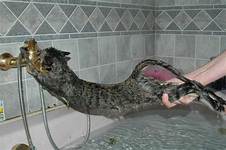 bathing, as a protection to you.
bathing, as a protection to you.
Give the cat a good brushing first. This process will remove any lost hair or mats. Then put cotton in his ears, gently, to keep the water out. Place a rubber bath mat in the sink or tub, and place your kitty on that. This will keep him from slipping or falling.
Place three or four inches of lukewarm water in the bath container. Wet the kitty thoroughly with a long-handled spray hose. Don’t spray directly in ears, eyes, and nose. If you have no spray hose, you can use a plastic pitcher or an unbreakable cup.
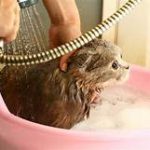 Gently massage your kitty with a solution that is one part cat shampoo to five parts water. Do not use human shampoo, as that can dry out his skin.
Gently massage your kitty with a solution that is one part cat shampoo to five parts water. Do not use human shampoo, as that can dry out his skin.
Massage the cat from head to tail, in the direction that the hair grows. Avoid the face, eyes, and ears. Then rinse the shampoo thoroughly off the cat. Use the spray hose again, or a pitcher. Be sure the water is lukewarm. Remove all traces of the shampoo, as it can irritate kitty’s skin. It can also draw dirt to it, if not thoroughly rinsed off.
Use a washcloth to wash kitty’s face, carefully. Then wrap him in a large towel and dry him off. Do so in a warm place, away from any drafts. If kitty doesn’t freak at the noise, you can use a blow-dryer to dry his fur, set on the lowest setting. If you have a long-haired kitty, you may need to use a wide-toothed comb to untangle his fur.
fur, set on the lowest setting. If you have a long-haired kitty, you may need to use a wide-toothed comb to untangle his fur.
After the ordeal is completed, reward your cat with lots of praise and his favorite treat.
Here’s the Brushing Technique
It is amazing what a good brushing will do. First, it removes dirt, grease, and dead hair from his coat. It also helps in the removal of skin flakes, and it stimulates blood circulation. The brushing process improves the cat’s overall skin condition.
Give one or two brushings per week. These regular grooming will be especially beneficial as the cat ages and has more trouble grooming himself.
Before you brush kitty, check his coat for general condition. A healthy coat will have a natural gloss. Also, it will spring back under your hand when you smooth it. You should see no bald spots and no sign of fleas or ticks. Check that kitty’s skin is free of any wounds or unusual bumps.
 Obviously, a short-haired cat is easier to groom than a long-hair. Use a metal comb. Work it through the cat’s fur from head to tail to remove any debris or dirt. Brush him in the direction the fur grows. Brush the whole cat, including cheeks and abdomen.
Obviously, a short-haired cat is easier to groom than a long-hair. Use a metal comb. Work it through the cat’s fur from head to tail to remove any debris or dirt. Brush him in the direction the fur grows. Brush the whole cat, including cheeks and abdomen.
Work on one section of the cat at a time to remove any dead hair or tangles. A rubber brush is very effective for hair removal on a short-haired cat.
If your cat is long-haired, give him a brushing every few days, as he will shed throughout the year. The grooming sessions are important to remove that dead hair and to keep the fur from tangling.
Start with the abdomen and legs. Comb the fur gently upward toward your kitty’s head. That soft, lovely neck fur gets combed upwards toward his chin. Make a part down the middle of the tail. Then gently brush out the hair on either side of the part.
Use talcum powder to sprinkle over knots, then separate them gently with your fingers. If they don’t come out, try a mat splitter.
The above pictures are from Kristina Kropat, professional cat groomer
Do A Cat Body Check-Up
As mentioned earlier, during your grooming sessions, run your hands over the cat’s body. Check to make sure there are no wounds, bumps, or tangles that you missed. Check under the tail for feces attached to the fur. These can be snipped off very carefully with scissors.
While you are looking under the tail, also check the anus. If you see tan, rice-sized objects, your cat may have tapeworms, and, in this case, will need the proper treatment.
If you don’t groom your pet, especially if it is long-haired, the cat could have tangles that are painful and need to be removed. Also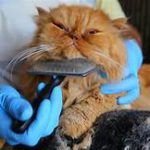 , your cat may have hairballs. You will know if he does, because he will cough them up or they will come out with the feces in the litterbox.
, your cat may have hairballs. You will know if he does, because he will cough them up or they will come out with the feces in the litterbox.
If you brush your cat regularly and the poor baby still suffers from hairballs, ask your vet to recommend a remedy that you can give your cat.
The cat’s skin is a barometer of his overall health. You may notice the cat scratching excessively, or chewing and/or licking. There are any number of causes for this behavior, from parasites and allergies to changing of the seasons or stress. Any one of these might affect your kitty’s skin, and if you notice a problem, see your vet.
Possible Skin Abnormalities To Watch For
Here are some causes of abnormalities in your cat’s skin that should be investigated:
RINGWORM
Ringworm is a highly contagious fungal infection that can cause inflammation, scaly patches and hair loss. The lesions are most commonly found on the head, ears, and paws. If you think your cat may have ringworm, even if you can’t find the lesion, see the vet immediately. You don’t want other pets or people being infected.
FLEAS
These little critters irritate the skin. Also, cats can have an allergic reaction to them. The cat will scratch excessively, and the hair above the base of the tail will thin. Crusts and red, raised skin lesions may occur. To top that off, the cat can sometimes be sensitive to flea treatment problems.
OTHER EXTERNAL PARASITES
Ear mites cause itching and redness around the ears. You can see a dark material that looks like coffee grounds in the ear canals. Other external parasites include lice and mange mites.

There are many other reasons your kitty’s skin may be having problems. These include seasonal and food allergies, reactions to grooming products, changes in season, environmental factors, bacterial or yeast infections, tumors, and stress. Visit your vet if you notice any abnormalities in the cat’s skin.
Ear Care
Check the ears once a week for wax, debris, or infection
Healthy Paws
Examine and clean the cat’s paws and make sure they are wound-free.
Nail Care
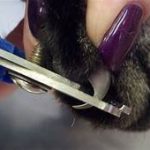 I know from experience that trimming the cat’s nails can be a nightmare experience for cat and owner. Here are some steps to follow to get your kitty to relax while you trim.
I know from experience that trimming the cat’s nails can be a nightmare experience for cat and owner. Here are some steps to follow to get your kitty to relax while you trim.
1. Choose a chair in a quiet room where you and kitty can sit and relax together. You might try this procedure after a meal, as he will be relaxed and perhaps sleepy. Make sure there are no distractions.
2. Take a paw between your fingers and gently massage. If the cat pulls away, don’t squeeze or pinch. Just follow his gesture, and keep a gentle contact. Once he is still, press his pad so that the nail extends. Then release the paw and give kitty a treat. Do this every other day until you have done all ten.
3. Get the cat used to the sound of the clippers before trimming the nails. Sit with the cat in your lap. Put a piece of uncooked spaghetti into the clippers and hold them near your cat. You might set a treat for him on top of the clippers. Next, massage a toe, gently pressing the toe pad. When the nail extends, clip the spaghetti with the clippers while still holding his paw. Now release the toe and give kitty a treat.
4. Do NOT cut the pink part of the nail, called the quick, which is where the nerves and blood vessels are located. Be cautious if you need to, and cut less of the nail rather than risk cutting the quick.
5. The cat should be on your lap, facing away from you. Take one toe in your hand; massage and press until the nail extends. Trim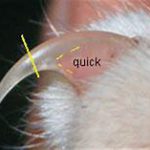 only the sharp tip of one nail, release the toe, and give kitty a quick treat. If the cat didn’t notice, clip another nail. However, just trim two claws in the first sitting…let your cat get comfortable with the experience. Don’t forget the reward.
only the sharp tip of one nail, release the toe, and give kitty a quick treat. If the cat didn’t notice, clip another nail. However, just trim two claws in the first sitting…let your cat get comfortable with the experience. Don’t forget the reward.
6. Trim nails every 10 days to two weeks.
7. If your cat resists, don’t punish her or raise your voice. Don’t attempt clipping if the cat is agitated or you are upset. Take your time. Don’t cut into the quick.
8. Don’t do all the cat’s claws at one time.
9. Do NOT declaw your cat! Instead, trim those nails regularly. Provide adequate scratching posts or get soft plastic covers for your cat’s claws. When you declaw your cat, the surgery involves amputating the end of a cat’s toes. Imagine how you would feel if someone cut off the ends of your toes? Don’t be so cruel!
Dental Care
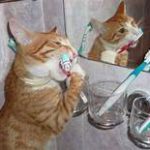 Damage to the tongue, teeth, palate and gums can lead to many health risks for a cat. You can prevent such problems from arising by brushing the teeth regularly. If kitty’s gums are inflamed, see a vet.
Damage to the tongue, teeth, palate and gums can lead to many health risks for a cat. You can prevent such problems from arising by brushing the teeth regularly. If kitty’s gums are inflamed, see a vet.
To brush a cat’s teeth, use cotton swabs and a small toothbrush and tube of toothpaste formulated for cats. You can also use salt and water. Never use people toothpaste, as some of the ingredients may be harmful for your cat.
To brush your cat’s teeth, you must first get the cat used to the idea. Start with your fingers or a cotton swab and gently massage the gums. After doing the gum massage for a few times, put a little of the cat toothpaste on his lip so he will become used to the taste.
Use a cat’s toothbrush, which is smaller than a human one, with soft bristles. You can also get a brush that you can wear on your finger. Apply toothpaste and give a gentle brushing.
To make your kitty’s teeth strong, get her chew toys. These will help floss those kitty teeth, massage gums, and remove tartar.
Check your cat’s mouth for any sign of gum disease or inflammation.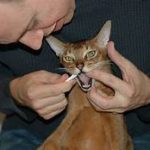
Eye Care
Give your kitty an eye exam just before grooming. Look for any tearing, crust, cloudiness or inflammation that may indicate a health problem.
The best way to prevent eye conditions is to get regular checkups and get the animal all the needed vaccinations. Eye conditions left untreated can lead to impaired sight or blindness.
To make your grooming job easier, I’ve found some grooming tools and supplies that you might find useful. These come from Amazon. As an Amazon affiliate, I may earn a small commission if your purchase any of these products.
Safari Pet Products Medium Coarse Metal Dog Grooming Comb
(Recommended by Kristina Kropat for your cat)
by Pet Combs
Price: $13.65
Pet Grooming Gloves — Left & Right, enhanced, five-finger design
For cats, dogs, and horses
by Pat Your Pet
Price: $13.99 Prime
Pet Nail Clippers and Claw Trimmers for small animals
Best cat nail clippers and claw trimmers for home grooming
by Shiny Pet
Price: $9.99 Prime
Mars Coat King Double Wide Dematting Undercoat Grooming
Rake Stripper Tool
Stainless with wood handle
Price: 35.99
Shed Magic Deshredder for cats
by Top Dawg Pet Supplies
Price: $14.59 Prime
Sleek EZ Original deshedding grooming tool, up to 95% less shedding in one use
by Sleek EZ (Cat owners: Do not press firmly against cat’s coat and use sparingly)
Available in 3 sizes: 2.5″, 5″, and 10″
$14.95 for 2.5″, Prime
Safari cat self-cleaning slicker brush, 1 size, cat brush
For shedding and grooming
Stainless steel comfort grip handle
Price: $11.80 (3rd party seller)
Wahl Professional Animal Bravura Cordless
Lithium Pet Clipper, Purple, #41870-0423
by Wahl Clipper Corp.
Price: $154.35 Prime
Espree Energee Plus Cat Shampoo, by Espree
Price: $14.93 Prime
Oxyfresh Premium Pet Dental Care Solution (16 oz.)
Best way to eliminate bad dog and cat breath; fight tartar, plaque and gum disease
by Oxyfresh
Price: $16.49 Prime Vet Recommend
by Virbac
Price: $14.99, free shipping
NAZVA Pet Supplies Silver Vine Matatabi Catnip Sticks
Natural toothbrush dental care
by NAZVA
Price: $11.95 Prime
Grooming your pet is a task that must be done regularly. Your attention to your animal’s care will bring you rewards, as you will be helping to keep your kitty healthy and happy.
If you learned something important from this article, please comment below.

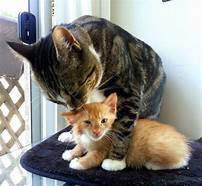















Hi CCL and thank you for sharing this great information
I have a friend who has a red seal Persian and boy does he get knotty so will send this link to her so she can come and learn some things to help old Bert feel and look better
Great post
Glad you found the post of value, Vicki. Your friend can also consult with Kristina Kropat, if she’d like, and get some information from an expert. After viewing the post, she can get hold of Kristine through me, if she needs to know more. Thanks for your comment! CCL
I have always found grooming my cat to be a mix of pleasure and pain. There are parts she absolutely loves, like me brushing her with my grooming tool. It’s cool because it gets deep down and pulls out all that fur. She absolutely hates water, however, and I wish so much she liked it. I always use warm water and try so hard to soothe her, but she howls at me like I’m killing her and her face just shows how unhappy she is. LOL. All your tips are so useful, and I so appreciate your website and all the neat things for sale. Thanks for another awesome article!
It is interesting — cats are so individual. Some of them like to be brushed; some don’t. Some like water; some hate it. I didn’t bathe my cats unless they got into something they couldn’t get off themselves, but for both of us it was a traumatic experience. So glad you found the tips useful, and that you like the site.
Have you read the Lucinda the literate cat book reviews? I think they are my favorite posts. Lucinda tells the book story, but interprets it in cat fashion. They are great fun.
Thank you, Fran, for what is undoubtedly the best and most comprehensive set of advice on cat grooming I’ve ever read.
We had two Scottish Folds, male and female litter mates (brother and sister) who were just the most delightful companions you could imagine. I don’t recall either of them ever putting out a claw in anger. The only time you even noticed their claws was when they were padding you affectionately or she was clinging to your chest and didn’t want to be put down!
The ate together, slept together and played together.
Both black and white, she was short haired and he was long haired. They both enjoyed being groomed.
Sadly, she died a couple of years ago and he’s now around 15 years old.
So he’s not as good at grooming himself as he used to be and his fur tends to get matted easily.
We will make really good use of the advice in this article, Fran and have a close look at some of those grooming tools that you’ve recommended.
I am so glad the article is helpful. Yes, as they get older they do require some help with the grooming. The tools on there are good ones, as I had the groomer look over the list. She took a few that I’d selected out and added the ones she recommended as the best to use. There are some that will be very helpful for matting.
Poor baby, to have lost his companion. It is good he has a loving human family to look after him.
Thank you so much for all of these cat grooming tips! We have both dogs and cats, and I have no problem grooming the dogs. But it’s always been difficult grooming the cats, and I think it’s because they’re just so terrified. I can get our brush out, but if even one cat sees it, you won’t find any of them the rest of the day! I think spending more time and just doing a little bit each day will start to make it less of a horrible experience for all of us, lol.
Well, it is too bad they don’t like brushing. Most cats seem to like it, in my experience. I think you are right, though. If you just do a little at a time and give them some treats, perhaps, maybe they will get more used to it. Your cats remind me of myself when I was a small child. I had really long hair, and when Mother got out the hairbrush, I would hide if I could. Good luck!
Hello Fran, thanks for the comprehensive information here. I’m new to grooming cats. I’ve had dogs all my life but am now looking after a cat and to be honest was a little lost. She has long hair and she is a delight but I’m still learning how to groom her. Looking after a cat is absolutely nothing like looking after a dog so I’m really pleased I found your post. Thanks
I’m so glad you found it helpful. It is especially important with a long-haired cat to make sure the tangles are out of her fur. They get a bit hard for the cat to take out with its tongue. The tools that are on there are for the most part the ones recommended by the cat groomer. She told me to remove a couple of the ones I had on there and to add other ones. There are some that should be very helpful for a long-haired cat.
Thank you for the article. My husband and I have 8 cats and have had to give our share of baths at times. I like your tip about brushing before the bath. We will try that next time. I can see how that would help.
My husband is in charge of cutting nails. He uses a very soothing voice when he cuts their nails. That seems to help as well.
Thanks for some tips on the dental care. I have one kitty that needs to have his teeth brushed and I’m having trouble. I will try your suggestions.
Have you found that your kitty is better with bath time each time? It seems like ours just don’t like it. (Even though they LOVE to play in the water).
Eight cats? You are a busy cat mom!
To tell you the truth, I only bathe my cats if absolutely necessary. Mostly, they do a good job on their own. Sometimes they can get into something that requires a bath, but I give one only if I have to. The cat is happier that way. Like yours, he loves to play in the water — especially in the bathroom sink — but he does not like the whole bathing idea.
How lucky, that your husband can cut their nails. I tried once with Carlos, my last cat, and he did not like it one bit. We got the job done, but I took him to the vet after that.
Wow, what an informative article on how to groom a cat. I have never really owned a cat, but I have lived with several people that owned cats. I had no idea so much work went into the grooming process. I definitely see de-clawing as being mean to the animal. I like the way you broke down the process into steps and guidance for each step.
I have had to bath dogs before, but not a cat. It seems to be a bit trickier with cats and looks like it requires more patience. I know many cats have different personalities and not all strategies work on every one. These informative steps will come in handy when I do decide to get a cat.
I have seen a cat with ringworm and it was not a fun process for the poor cat, but eventually she recovered. Many of these parasites are picked up from going outside and not spraying around the house for bugs. I may check out some of the products that you have recommended. I have some friends that are pet owners and may want to find out a better way to groom their pets. This way, they don’t have to take them to the vet or pet groomer so often. Thank you for sharing your experience and the cat grooming process. I feel alot more educated on the subject now.
So glad you found the article informative. There’s a lot of good information on there.
As to bathing a cat, I would recommend doing so only if necessary. One time one of my cats was chasing off a Tom who was in his territory. The chase led them through a swamp. My cat went in one color and came out another. I had to bathe him to get off all the mud. He was not a happy camper, but we got the job accomplished.
If you would like to share this article with friends, I would be delighted!
Thanks for your informative article. I liked it because I’ve always liked cats, at one point having as many as six for my two kids. None of us knew that there were special ways to care for cats, other than to make sure that they had food to eat and a good clean place in which to roam, play, and sleep. We enjoyed them thoroughly when my children were young, but had to let them go eventually. I wish that I’d had read your article earlier in time; I’m sure I would have enjoyed it as much, and would have profited from it even more.
Well, Hugo, I am glad you read it now. Who knows when you might need that information? There’s a lot of information in that article that I hope will be helpful to cat owners. Thanks for the comment.